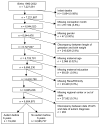Month of conception and risk of autism
- PMID: 21543984
- PMCID: PMC3296777
- DOI: 10.1097/EDE.0b013e31821d0b53
Month of conception and risk of autism
Abstract
Background: Studies of season of birth or season of conception can provide clues about etiology. We investigated whether certain months or seasons of conception are associated with increased risk of autism spectrum disorders, for which etiology is particularly obscure.
Methods: The study population comprises 6,604,975 children born from 1990 to 2002 in California. Autism cases (n = 19,238) were identified from 1990 through 2008 in databases of the California Department of Developmental Services, which coordinates services for people with developmental disorders. The outcome in this analysis was autism diagnosed before the child's sixth birth date. The main independent variables were month of conception and season of conception (winter, spring, summer, and fall). Multivariate logistic regression models were used to estimate odds ratios (ORs) with their 95% confidence intervals (CIs) for autism by month of conception.
Results: Children conceived in December (OR = 1.09 [95% CI = 1.02-1.17]), January (1.08 [1.00-1.17]), February (1.12 [1.04-1.20]), or March (1.16 [1.08-1.24]) had higher risk of developing autism compared with those conceived in July. Conception in the winter season (December, January, and February) was associated with a 6% (OR = 1.06, 95% CI = 1.02-1.10) increased risk compared with summer.
Conclusions: Higher risks for autism among those conceived in winter months suggest the presence of environmental causes of autism that vary by season.
Figures



Comment in
-
Autism spectrum disorders: is anything left for the environment?Epidemiology. 2011 Jul;22(4):489-90. doi: 10.1097/EDE.0b013e31821d0b6d. Epidemiology. 2011. PMID: 21642775 No abstract available.
Similar articles
-
Season of Conception and Risk of Cerebral Palsy.JAMA Netw Open. 2023 Sep 5;6(9):e2335164. doi: 10.1001/jamanetworkopen.2023.35164. JAMA Netw Open. 2023. PMID: 37738049 Free PMC article.
-
Association of autistic spectrum disorder with season of birth and conception in a UK cohort.Autism Res. 2010 Aug;3(4):185-90. doi: 10.1002/aur.136. Autism Res. 2010. PMID: 20803726
-
Season of conception is associated with future survival, fertility, and milk yield of Holstein cows.J Dairy Sci. 2017 Aug;100(8):6631-6639. doi: 10.3168/jds.2017-12662. Epub 2017 Jun 7. J Dairy Sci. 2017. PMID: 28601450
-
A new model to study season-of-conception effects on child neurodevelopment based on maternal history of seasonal affective disorder.Psychiatry Res. 2025 Jun;348:116430. doi: 10.1016/j.psychres.2025.116430. Epub 2025 Mar 10. Psychiatry Res. 2025. PMID: 40101442
-
A profile and review of findings from the Early Markers for Autism study: unique contributions from a population-based case-control study in California.Mol Autism. 2021 Mar 18;12(1):24. doi: 10.1186/s13229-021-00429-7. Mol Autism. 2021. PMID: 33736683 Free PMC article. Review.
Cited by
-
Environment and Autism: Current State of the Science.Cut Edge Psychiatry Pract. 2014 Summer;1(4):21-38. Cut Edge Psychiatry Pract. 2014. PMID: 27453776 Free PMC article.
-
Autism spectrum disorder, flea and tick medication, and adjustments for exposure misclassification: the CHARGE (CHildhood Autism Risks from Genetics and Environment) case-control study.Environ Health. 2014 Jan 23;13(1):3. doi: 10.1186/1476-069X-13-3. Environ Health. 2014. PMID: 24456651 Free PMC article.
-
Season of Conception and Risk of Cerebral Palsy.JAMA Netw Open. 2023 Sep 5;6(9):e2335164. doi: 10.1001/jamanetworkopen.2023.35164. JAMA Netw Open. 2023. PMID: 37738049 Free PMC article.
-
Maternal inflammation and its ramifications on fetal neurodevelopment.Trends Immunol. 2022 Mar;43(3):230-244. doi: 10.1016/j.it.2022.01.007. Epub 2022 Feb 5. Trends Immunol. 2022. PMID: 35131181 Free PMC article. Review.
-
Autism Spectrum Disorders: Multiple Routes to, and Multiple Consequences of, Abnormal Synaptic Function and Connectivity.Neuroscientist. 2021 Feb;27(1):10-29. doi: 10.1177/1073858420921378. Epub 2020 May 22. Neuroscientist. 2021. PMID: 32441222 Free PMC article. Review.
References
-
- Brown AS, Begg MD, Gravenstein S, Schaefer CA, Wyatt RJ, Bresnahan M, Babulas VP, Susser ES. Serologic evidence of prenatal influenza in the etiology of schizophrenia. Arch Gen Psychiatry. 2004;61(8):774–80. - PubMed
-
- Chess S. Autism in children with congenital rubella. J Autism Child Schizophr. 1971;1(1):33–47. - PubMed
-
- Desmond MM, Montgomery JR, Melnick JL, Cochran GG, Verniaud W. Congenital rubella encephalitis. Effects on growth and early development. Am J Dis Child. 1969;118(1):30–1. - PubMed
-
- Waldman M, Nicholson S, Adilov N, Williams J. Autism prevalence and precipitation rates in California, Oregon, and Washington counties. Arch Pediatr Adolesc Med. 2008;162(11):1026–34. - PubMed
Publication types
MeSH terms
Grants and funding
LinkOut - more resources
Full Text Sources

